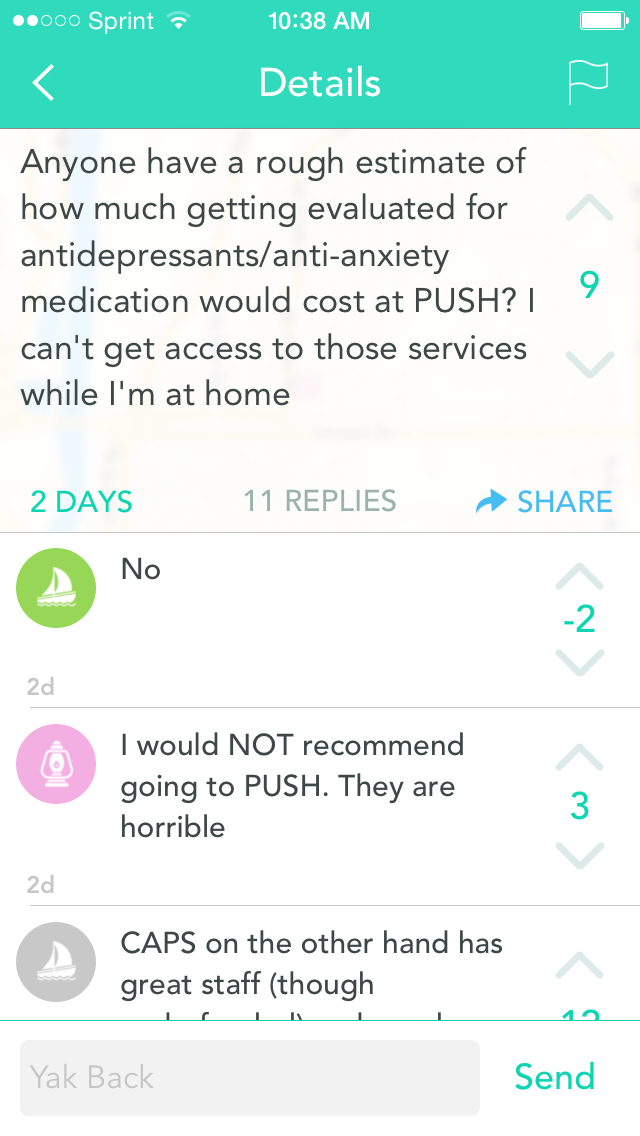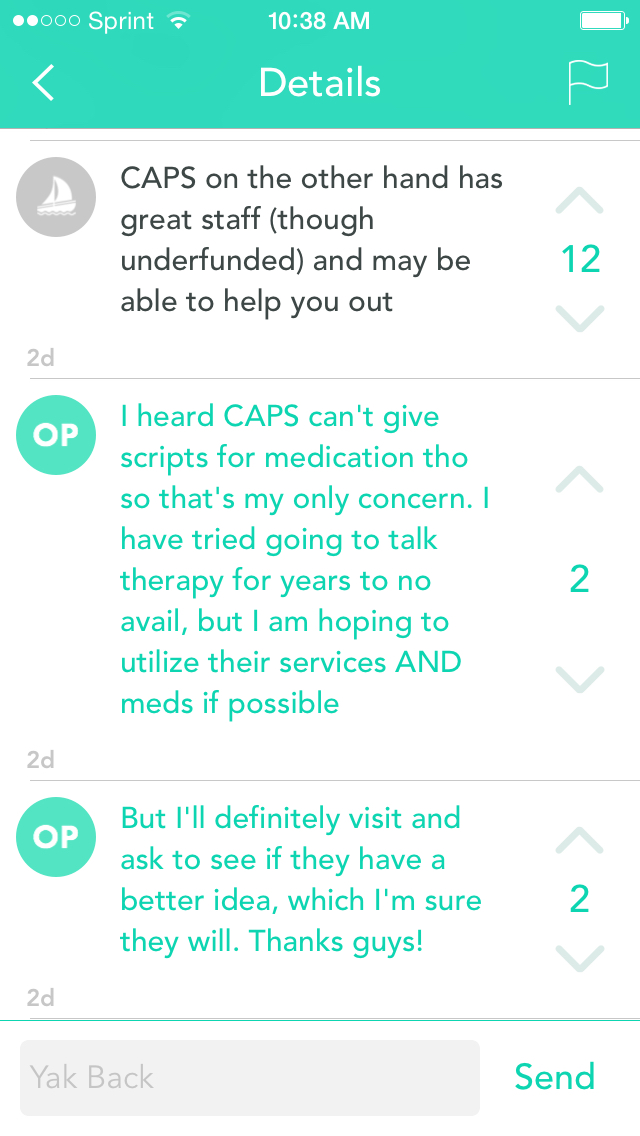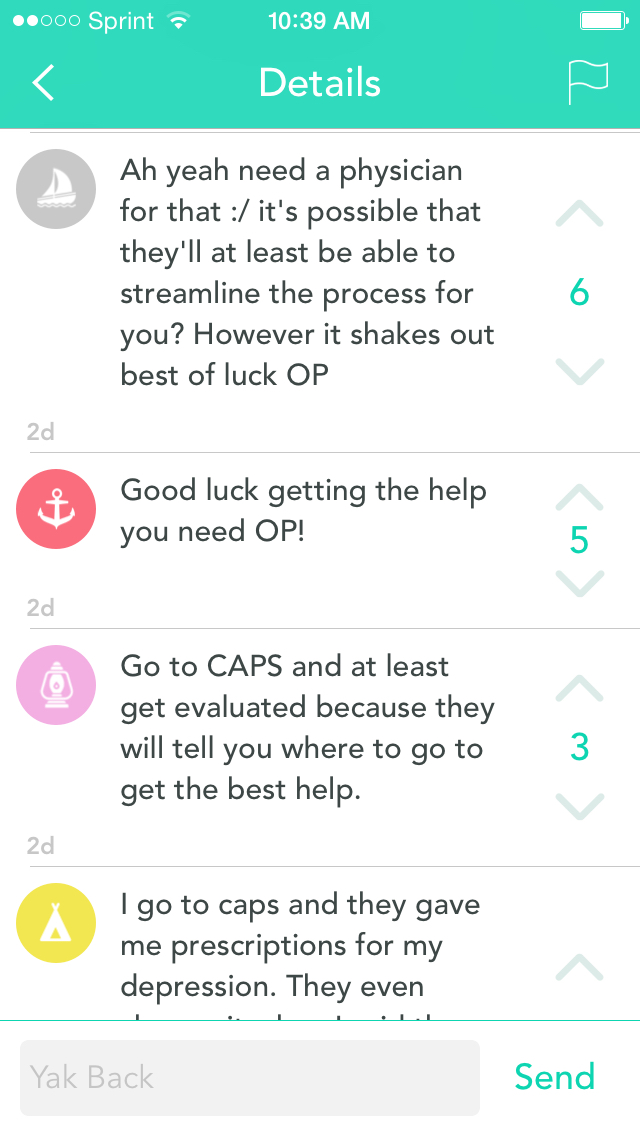
Relatedness:
Consider our desire to move towards entities
Yik Yak proved to be a compelling application for users on college campuses because of the affordances it presented: the platform was easy to learn, both Apple and Android versions were available for download, and posts on the application reached a wide audience, because the application didn’t depend on pre-existing social networks for the dissemination of information. Even though local Yik Yak feeds were based on geographic parameters, and were organized according to chronological time, the content generated by users was still incredibly fluid, and illustrated the varieties of users, experiences, and sensations circulating through the network. Affect offers a useful approach to unpacking these experiences, as they were, in many cases, infused with intense feelings and emotions. While definitions of the concept vary across fields and traditions, a key aspect of affect is its relational nature. When we feel, sense, or experience something, we move towards a particular perception of that thing, or away from it, based on a multitude of factors. In light of this, affect "rises and falls not only along various rhythms and modalities of encounter but also through…sensation and sensibility" (Seigworth & Gregg, 2010, p. 2). Thus, it is often the center of coalescing forces, making it captivating, yet difficult to isolate.
Sara Ahmed (2010) argued that as affect shifts, we think of it as "what sticks, or what sustains or preserves the connection between ideas, values, and objects" (p. 29). The stickiness of something, then, is the force that builds (or disassembles) our connection to that something, and is not "the property of an object," but rather, circulates among objects "as it accumulates and affects that which it touches" (p. 91). As a result, the stickiness of an object increases as it moves. The stickiness of posts on social media are represented by likes, favorites, upvotes, and similar markers, illustrating the effects of affect. The rhythms of affect that rise and fall are undoubtedly part of the "coordinating processes, moving across the same social field and within shared structures of feeling" in rhetorical ecologies (Edbauer, 2005, p. 20). Particularly powerful in these shared structures of feelings are the intensities that drive us towards objects, such as perceived similarities, the use of humor, and moments of thoughtful collaboration. The anonymous nature of Yik Yak provided students with an environment that highlighted feeling generated by content, rather than the identity of original posters, encouraging them to think through the converging forces producing these heightened feelings. Ideally, if students can reflect on these moments of shared, heightened feeling, they can perhaps foster more of these moments in the future by tapping into affective rhythms in similar digital environments; one of the attempted outcomes of the assignment discussed in this webtext was an awareness of these shared moments.
Tapping into Perceived Similarities
In their reflective essays, students wrote extensively about posts referencing the ups and downs of living on a university campus, a topic that many users of the feed could presumably relate to. They provided many examples, such as dealing with roommate issues, running out of dining dollars, having early morning classes, studying for exams, and visiting friends on other campuses. Despite worries from some students that their posts would be dismissed due to their personal nature, these topics elicited a high level of engagement from other users on the network. Luke posted a series of relationship-based yaks (below) because he noticed that this was a common topic on the Purdue feed, but also that "there were a lot of cases of people making fun or putting down other users" with these types of posts.

![Screenshot of Yik Yak post and replies, Spring 2015. Original post reads, 'When you're trying to explain that dancing up on another guy is not ok to your girlfriend and it's like she doesn't even realize your [sic] mad...' Replies include, 'Yeah, that's nto cool of her. Hang in there.'](images/relatedness2.png)


However, Luke was surprised by the feedback that he received on these posts, writing that, "In fact, when it came down to posting my yaks about various relationship topics, most of the comments I received were encouraging or empathetic." The first two posts feature a high number of up votes, and earnest replies—especially the post that vents about a disagreement with his girlfriend. Instead of a sarcastic reply, he received messages of support, like, "Yeah, that’s not cool of her. Hang in there." These feedback mechanisms are part of the affectual rhythms of the application: these commenters felt enough intensity towards Luke’s original post that they decided to reply (and presumably upvote the post), showing him support. It seems that the topic of relationships resonated for many users on this feed. For Yik Yak users, drawing near to objects via affect was illustrated by "qualitative affordances," or the systems that "illustrate reader reaction to posts" (Tarsa, 2015). On Yik Yak, as well as many other platforms, the stickiness of an emotive reaction was displayed through qualitative affordances like favorites or upvotes, and the voting system illustrated the levels of stickiness that these posts could conjure up: high numbers of up votes signalled a high amount of resonance, or stickiness, while low numbers of upvotes signified the opposite.
Using Humor to Connect with Other Users
Humor, a nearly constant theme in student reflections and common on the application in general, was one way that users seek to establish a connection with others on the network. Phil wrote, "the most popular yaks are ones that have some sort of extravagance, originality, and relatability to them. In addition, yaks that include humor are also more encouraged than other basic yaks." Robert’s work supported this, stating that "humor is almost always involved" with posts that were highly upvoted, and then provided an example of his own successful post: "Why do we even have math final exams? The only addition we need is 50 stars + 13 bars = ‘MERICA." This post gained 155 upvotes, and illustrated Robert’s ability to engage with the affective network of his peers, as his post conjured up feelings of relatability through its content and humorous approach. Sara Ahmed explained that, "An object can be affective by virtue of its own location (the object might be here, which is where I experience this or that affect) and the timing of its appearance (the object might be now, which is when I experience this or that affect" (2010, p. 33). Robert’s yak, which referenced the popular trope of over-zealous patriotism through his use of "‘MERICA," clearly resonated with his audience at that point in time. This post illustrates the confluence of time, cultural location, and affective intensity, suggesting the importance of each aspect of the ecological network of Yik Yak.
Utilizing Anonymity as a Way to Share Resources
Despite Yik Yak’s admittedly chaotic possibilities and unsavory reputation, many students in this sample did suggest that the application had a lot of value, thanks to its local focus and anonymous profiles, which created a unique opportunity for users to share thoughts that they might otherwise have kept to themselves. In these moments, users shared resources and information in serious, helpful ways. For example, below are screenshots from Purdue University’s feed in Fall 2015 that show students talking about mental health struggles and sharing resources on campus in a kind, non-judgmental way.



![Screenshot of Yik Yak replies, Spring 2015. Replies include, 'I go to caps and they gave me prescriptions for my depression. They even change [sic] it when I said they were not working on me. Changed it two times before I found something that worked for me.'](images/relatedness8.jpg)
These screenshots show a dialogue unfolding from one original post asking for advice about the on-campus counseling services available through the Purdue University Student Health Center (or PUSH). Suggestions and advice seem to be given in earnest, including to go to the Counseling and Psychological Services (CAPS) center for more specialized help. The original poster (OP) is clearly pleased with the responses on the yak, writing, "Again, seriously thank you guys so much. You all are the best!" The users who responded with messages of support and information about resources presumably felt drawn toward the original posts, so much so that they wanted to reply. There are a number of reasons why they would want to engage with the content of these posts (or the original poster), and as the posts remained on the feed, gathering more replies and upvotes, the stickiness increased. Posts like these are not the majority of what one typically found on Yik Yak—but their presence reveals that the affordances of the application were sometimes used to promote positive engagement among college students.
The anonymity of Yik Yak allowed these students to reach out to the network in ways that more traditional, profile-based platforms might not have allowed: while some students might feel comfortable asking questions publicly about sensitive topics like mental health, many others might not. So Yik Yak, and other anonymous applications, can provide spaces for users to share experiences, and in some cases, fears or insecurities, perhaps in the effort to foster a feeling of relatedness to other users. For example, users on Whisper, another anonymous, location-based application popular during Yik Yak's existence, could upload or use images already in the application and place text onto the pictures to craft messages. Posts on Whisper resemble the popular website Post Secret, and often are in the same confessional style.
At left, these two screenshots from the Whisper network surrounding Purdue in Fall 2015 are laden with emotion: one user expressing their feelings of failure, the other disclosing a past trauma (and its continued impact on their life). Whisper provides users with the opportunity to favorite and reply to posts, though discussion doesn't seem to unfold as much on this application as say, Yik Yak, perhaps due to Whisper's primarily visual content. Instead, Whisper offers an outlet for users to share their thoughts with their immediate geographic network by combining small amounts of text and evocative images, illustrating the potential for these types of applications to foster networks through affectual intensities. Users can reveal intimate details about their lives, receive support through comments or likes, and as a result, feel connected to other users in their immediate area without having to reveal their identities. Whisper is just another application that emphasizes the possibilities of content to conjure up connections between users in these dynamic, shifting networks that change as users move in and out of locations.
Posts on Yik Yak, and related applications, initially show up on a feed because of the shared location between users, but they stay on the feed longer if other users feel a connection to these posts (illustrated by their stickiness, represented by the upvotes and comments). And the more upvotes or comments a post has, the more it garners the attention of other users, increasing the intensities directed towards the original post. Of course, this also might come into play with posts that users wish to move away from, causing interruptions in relatedness. (This process can be observed on almost any social media platform: a heated Twitter exchange, or an extended comment thread on Facebook under a news story that your very politically active uncle just posted; though, once again, anonymous environments illuminate the factors contributing to that feeling outside of pre-existing relationships.) These nodes of feeling are just one factor in these digital environments that act upon other factors, as well as users themselves. Considering the affective processes that drive our experiences on social media platforms like Yik Yak provides us with a clearer understanding of how powerful these applications are for our students, further emphasizing the importance of cultivating a culture of digital stewardship in our classrooms. If we ask our students to pay attention to the rhythms of feeling that circulate on these types of applications, and how they manifest according to the affordances and constraints of the platform, they will be better prepared to engage ethically in digital spaces long after they leave our classrooms.








